Inari Sushi is sushi rice in a pouch made of seasoned aburaage (deep fried thin tofu). It is sweet but it complements the sourness of sushi rice. It is quite simple to make Inari Sushi, particularly when you use store-bought seasoned aburaage.
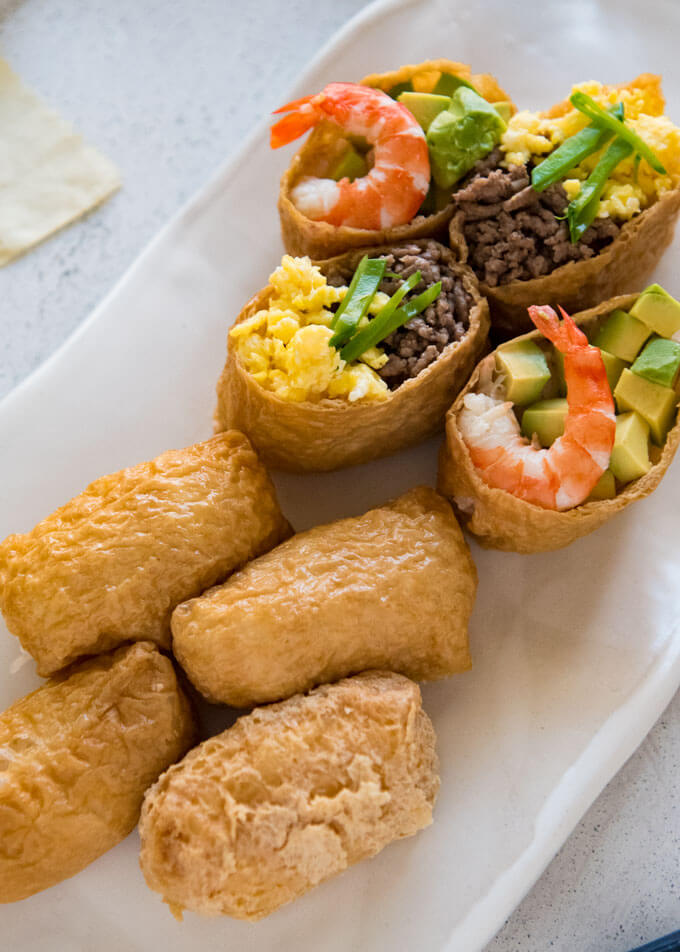
Among the various sushi recipes, Inari Sushi is one of the easiest. Unlike other types of sushi, Inari Sushi is very sweet and some people eat it at tea times.
What is Inari Sushi
I called it ‘Inari Sushi’ so that my readers will know that this is a sushi recipe. But in Japan, it is called ‘Inarizushi’ (いなり寿司 or 稲荷寿司), changing the sound ‘sushi’ to ‘zushi’ for easier pronunciation.
The most common traditional Inarizushi is a very simple rice dish that is basically the oval-shaped or triangle-shaped sushi rice ball wrapped in a seasoned aburaage (deep-fried thin tofu). Sometimes the sushi rice contains roasted sesame seeds, cooked vegetables and/or hijiki seaweed.
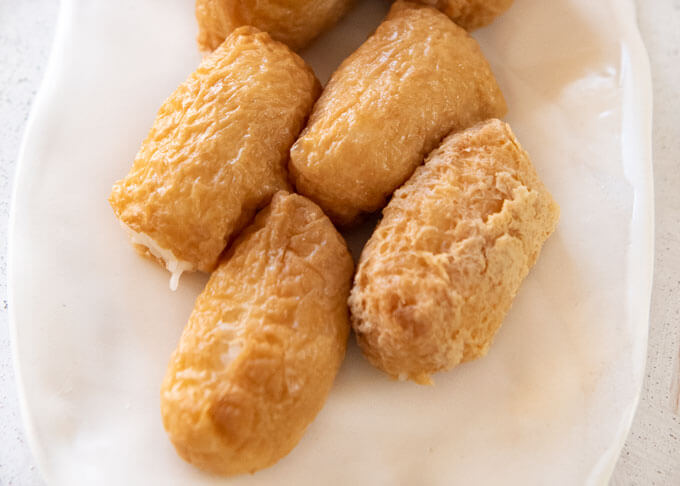
The modern version of Inarizushi is more decorative with colourful toppings, as you can see some of them in my photos.
The name of this sushi is associated with a type of shrine called ‘Inari Shrine’, which used to worship the deity, Inari. It is said that the favourite food of the fox, the messenger of Inari, was aburaage (deep fried thin tofu) so people offered aburaage to the shrine.
Because the sushi rice is wrapped in aburaage, it is called ‘inarizushi’.
Seasoned Aburaage Pouch
Before filling aburaage with sushi rice, the aburaage needs to be cut in half and cooked in a sweet soy-flavoured broth until the liquid almost evaporates. The aburaage pieces become a bit darker and shiny.
You can make seasoned aburaage pouches at home but today’s recipe is Quick Inari Sushi so I bought a pack of cooked aburaage, ready to fill with rice to make Inari Sushi.
The photo below is the cooked aburaage pouches that I bought from the Japanese grocery store.
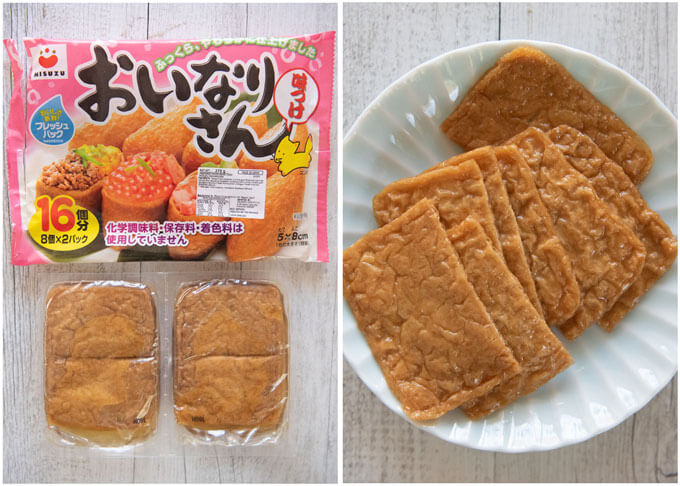
The aburaage comes in two vacuum sealed bags. Each bag contains 8 cooked aburaage pouches. If the bag is still vacuum sealed, it keeps quite a while and there is no need to refrigerate it. But once opened, you should keep it in the fridge and use it in few days.
They can also be purchased on-line on eBay and some online Asian food sites. You might also find canned cooked aburaage pouches. They are called ‘Inarizushi-no-moto’.
If you can’t get the cooked aburaage pouch, don’t worry. In the next post, I will introduce a recipe for Home-made Inari Sushi which explains how to make seasoned aburaage from scratch.
How to make Inari Sushi
If you are making traditional Inari Sushi, all you need is sushi rice and cooked aburaage pouches.
Make the sushi rice as per my recipe, Temakizushi (Hand Rolled Sushi). Since Inari Sushi does not contain raw fish, the sushi rice does not have to be completely cooled down. It can be slightly warm if you are in a hurry.
To fill an aburaage pouch, you will need about 30-35g of sushi rice (small handful). You can fill with more or less rice but 30-35g would make it the right size, I think.

Take a handful of rice and squeeze it gently in your hand to shape it into an oval ball.
Store-bought aburaage pouches usually come with a small amount of the liquid the aburaage pouches were cooked in. You need to squeeze the liquid out of the pouches before filling with the sushi rice.
Open the pouch and place the rice ball in it. The rice should fill about half or two thirds of the pouch. Cover the opening by folding one side of the aburaage, then fold both edges inwards. Fold the other side over and place the Inarizushi folded side down.
Inari Sushi Variations
There are different types of Inarizushi depending on the region in Japan. The shape can also be different.
In the northern part of Japan, Inarizushi is made into the squarish oval shape, like my Inarizushi. It represents the rice sack made of straw. But Inarizushi in the southern region is a triangle, which represents the ear of the fox.
Apart from the shape, there are three variations:
- Add cooked vegetables to the sushi rice.
- Use aburaage pouch inside out.
- Decorate with toppings.
In my photos, you can see the last two variations.
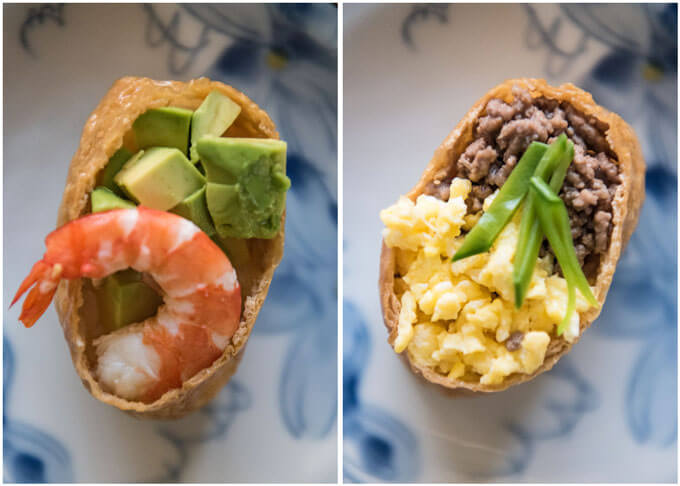
When you turn the pouch inside out, you will get quite a different texture and the colour of the aburaage is lighter. The method of making inside out Inarizushi is the same as the traditional one.
Decorating Inarizushi with Toppings
To decorate Inarizushi with toppings, leave the pouch open without covering and place a couple of toppings on the rice. The toppings can be almost anything as long as they go well with sushi rice.
It’s a bit difficult to eat Inarizushi with toppings compared to the traditional one but they certainly look gorgeous.
For the Inarizushi with toppings, I made cooked prawns with diced avocado and seasoned pork mince (ground pork) with Iri Tamago (finely scrambled egg). You can find how to cook seasoned mince (ground meat) and Iri Tamago in my post, Sanshoku Bento (Tri-coloured Rice Bowl).
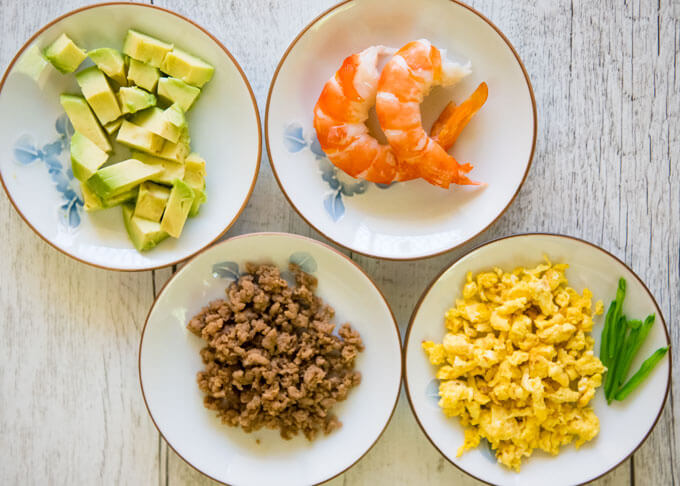
In Japan, Inarizushi is sometimes made with fancy toppings on special occasions. It is also packed in lunch boxes for school excursions.
My Inarizushi lunch for school excursions when I was a kid was filled with only simple Inarizushi with no toppings. I am not sure when Inarizushi with toppings was invented, but I am pretty sure it didn’t exist when I was a kid.
Yumiko![]()

Inari Sushi is sushi rice in a pouch of seasoned aburaage (deep fried thin tofu). It is sweet but the sourness of the sushi rice makes it easy to eat. It is quite simple to make Inari Sushi, particularly when you use store-bought seasoned aburaage.
Cook Time does not include time taken to cook ingredients, i.e. sushi rice and toppings. Prep time is only to prepare and assemble Inarizushi with prawn/avocado topping which takes longer than making traditional plain Inarizushi.
Don't forget to see the section 'MEAL IDEAS' below the recipe card! It gives you a list of dishes that I have already posted and this recipe that can make up a complete meal. I hope it is of help to you.
- 280 g sushi rice (note 1)
- 8 Inarizushi pouches (note 2)
- 8 medium size prawns , cooked and shelled (note 3)
- 8 tbsp diced avocado
- 8 tbsp seasoned pork mince (note 4)
- 8 tbsp iri tamago (note 4)
- julienned blanched snow peas (optional, note 5)
-
Divide sushi rice into 8 equal portions. Take each portion in one hand (note 6), squeeze gently and make an oval shaped ball. Make 8 oval shaped balls.
-
Take an aburaage pouch and squeeze liquid out. If you are making inside out Inarizushi, turn the inside of the pouch out.
-
Open the pouch and place a rice ball inside the pouch. Push the rice gently to both sides and fill the corners of the pouch with the rice.
-
Continue to the instructions below depending on the type of Inarizushi you are making.
-
Fold one side of the aburaage to cover the opening, then fold both edges inwards. Fold the other side over and place the folded side of the Inarizushi down.
-
Repeat for the rest of Inarizushi.
-
Place 1 tablespoon of diced avocado on top of the rice, covering half of the surface.
-
Place a prawn next to the avocado.
-
Repeat for the rest of Inarizushi.
-
Place 1 tablespoon of mince on top of the rice, covering half of the surface.
-
Place 1 tablespoon of iri tamago on the other half of the rice.
-
Place a couple of julienned snow pea pieces in the centre.
-
Repeat for the rest of Inarizushi.
1. Please refer to Temakizushi (Hand Rolled Sushi) for how to make sushi rice.
2. I used store-bought seasoned Inarizushi pouches. See the post for details and photo. You can buy them at Japanese grocery stores. You can also purchase them on-line on eBay and some online Asian food sites.
You might also find canned cooked aburaage pouches. They are called ‘Inarizushi-no-moto’.
If you want to make seasoned Inarizushi pouches yourself, please visit my post Home-made Inari Sushi.
3. I used a whole prawn on each Inari Sushi but you can cut it into small pieces if you want.
4. Please refer to Sanshoku Bento (Tri-coloured Rice Bowl) for how to make seasoned pork mince and iri tamago. The recipe uses beef mince but you can replace it with pork or chicken if you prefer.
5. Instead of snow peas, you can use a sliced cucumber as an alternative.
6. Wet your hand with the seasoned aburaage to prevent the rice from sticking to your hand.
Meal Ideas
A typical Japanese meal consists of a main dish, a couple of side dishes, a soup and rice. I try to come up with a combination of dishes with a variety of flavours, colours, textures and make-ahead dishes.
For some reason, Inarizushi goes well with deep-fried dish. So, I picked Karaage Chicken. You can adjust the quantity of Karaage Chicken depending on how many Inarizushi your diners may want to eat. If they love Inarizushi, they may become full by having many Inarizushi. Then you can serve Karaage Chicken as a side in a smaller quantity.
Sunomono cleanses the palate which is great to match with fried dishes. I picked clear soup for the same reason.
- Main: Japanese Fried Chicken (Karaage Chicken) – or Tempura
- Side dish 1: Octopus and Cucumber Sunomono (Vinegar Dressing) – alternatively, Cucumber and Seaweed Sunomono
- Side dish 2: Daikon Salad with Pickled Plum Dressing
- Soup: Japanese-style Egg Drop Soup (Kakitama-jiru) – or other clear soup
- Rice: Quick Inari Sushi – today’s recipe, can be made ahead

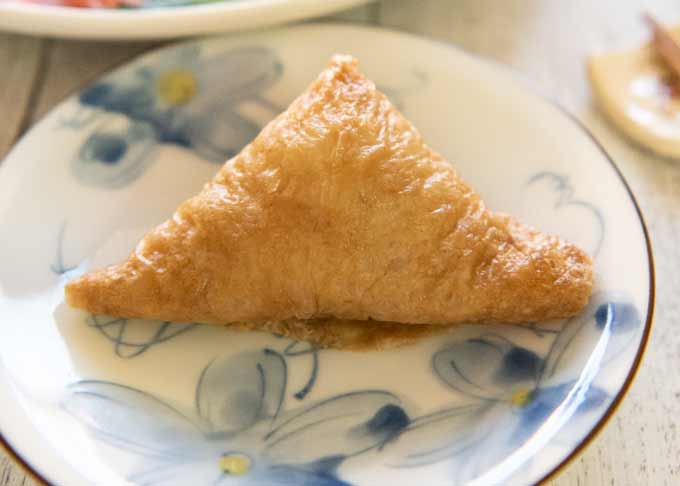
Hello Yumiko! I wanted to try making inarizushi with the Misuzu brand aburaage pouches and was wondering if the bag comes with rice vinegar and furikake as well or only the aburaage pouches?
Thank you for sharing such lovely recipes! 😊
Warm regards,
Lina
Hi Lina, it only comes with aburaage pouches ready to be filled in. Good luck with Inari Sushi. You will enjoy not only eating them but making them.
Hello Yumiko! Thank you for letting me know that it only comes with the aburaage pouches. It’ll be fun being able to make them at home.😀
Thanks again!
Very good recipe thank you dear editor
Hi Irmde, my pleasure!
I bought the same brand of pouches. The instructions are not in English so wondering if there is any prep for them? Warm them up in a sauce or can I just use them right out of the bag? Thank you for your ideas. They look so yummy. I was searching for something other than rice to put in them and I found your page!🥰
Hi Helen、no preparation is required. You can use it straight from the pack. Just make sure that the pouches are at room temperature so that the aburaage is soft to handle.
Serving as an open pouch with toppings is quite attractive too. I hope you enjoy it!
Hello Yumiko,
I just tried your recipe for dinner. First: It is delicious! I just had real problems opening the pouches and it took a lot of concentration. Do you have a trick?
And we had way too much rice left over so we added Furikake seasoning and made little onigiri out of it. How much uncooked rice should we use next time to get the amount of cooked rice needed?
Greetings
Hi E.M.,
I agree that opening the pouches could be a challenge. When I cook inari pouches myself, I roll a round chopstick over the whole aburaage to loosen up the inside of the aburaage and this seems to help. But the store-bought ones should already be treated so that the pouches can be opened easily. It might still be worth rolling a chopstick over the pouch before opening.
When rice is cooked, its weight becomes 2.1-2.2 times of the weight of the uncooked rice (in the case of Japanese rice). About 130g/4.6oz of uncooked rice will be needed to make 280g cooked rice per the recipe. Japanese measuring unit for rice, 1 gou (合) is 180ml/6.1fl oz and it weighs about 15og/5.3oz. So, 130g/4.6oz of rice is 156ml/5.3fl oz in volume.
Hello Yumiko,
thank you for the advice with the chopstick! I’ll try that next time. They still came out nice although with a hole here and there.
I bought the standard rice that you get here for making sushi. I’ll try it next time with your measurements. Thank you!
Greetings
Truly appreciate the way you made this yummy sushi. Everything is so nicely described that really helped me. I am looking forward for more such recipes in future too.
Hi Mobasir, I’m glad to hear that you liked Inari Sushi. Please do try other dishes and drop me a note!
This has been on my MUST DO LIST for a long time. Unfortunately I get distracted by your other recipes.
Thanks for the recipe. It’s being slotted in up the top.
Hi Paul. Good luck with Inarizushi. I also posted Home-made Inari Sushi if you want to make Inarizushi pouch from scratch. Your comment reminded me that I should add the link to the post. So, thank you!
Hi Yumiko,
I used to buy them at the local market at the fish stall and they had just pickled ginger…..loved
Them, now I can try making them for myself. Thank you.
Hi Merle, it’s surprisingly easy to make. See the following post Home-made Inari Sushi as well. It shows you how to cook seasoned aburaage from scratch.
Drooling one. Will definitely have a try.. Loved all your recipes..
Hi, Anu. Please do try. Thank you!
Love,love,love all your recipes. I’ve made sushi before but not inari. Looking forward to trying. Keep posting all the great recipes to try.
Hi Marjorie, thank you very much. Wait for the next post so that you can even make seasoned aburaage from scratch.